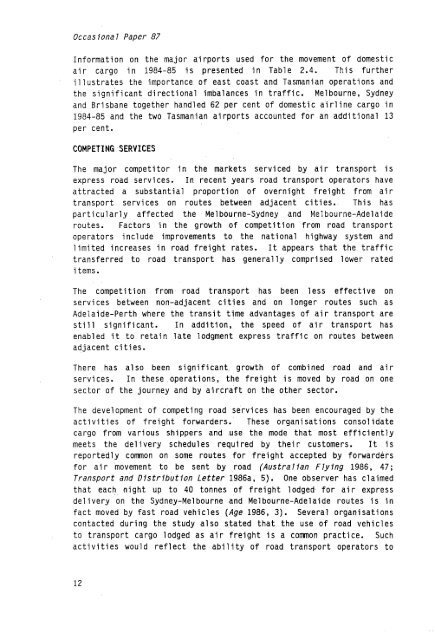Domestic Air Cargo Industry in Australia - Bureau of Infrastructure ...
Domestic Air Cargo Industry in Australia - Bureau of Infrastructure ...
Domestic Air Cargo Industry in Australia - Bureau of Infrastructure ...
Create successful ePaper yourself
Turn your PDF publications into a flip-book with our unique Google optimized e-Paper software.
Occasional Paper 87Information on the major airports used for the movement <strong>of</strong> domesticair cargo <strong>in</strong> 1984-85 is presented <strong>in</strong> Table 2.4. This furtherillustrates the importance <strong>of</strong> east coast and Tasmanian operations andthe significant directional imbalances <strong>in</strong> traffic. Melbourne, Sydneyand Brisbane together handled 62 per cent <strong>of</strong> domestic airl<strong>in</strong>e cargo <strong>in</strong>1984-85 and the two Tasmanian airports accounted for an additional 13per cent.COMPETING SERVICESThe major competitor <strong>in</strong> the markets serviced by air transport isexpress road services. In recent years road transport operators haveattracted a substantial proportion <strong>of</strong> overnight freight from airtransport services on routes between adjacent cities. This hasparticularly affected the Melbourne-Sydney and Melbourne-Adelaideroutes. Factors <strong>in</strong> the growth <strong>of</strong> competition from road transportoperators <strong>in</strong>clude improvements to the national highway system andlimited <strong>in</strong>creases <strong>in</strong> road freight rates. It appears that the traffictransferred to road transport has generally comprised lower ratedi tems.The competition from road transport has been less effective onservices between non-adjacent cities and on longer routes such asAdelaide-Perth where the transit time advantages <strong>of</strong> air transport arestill significant. In addition, the speed <strong>of</strong> air transport hasenabled it to reta<strong>in</strong> late lodgment express traffic on routes betweenadjacent cities.There has also been significant, growth <strong>of</strong> comb<strong>in</strong>ed road and airservices. In these operations, the freight is moved by road on onesector <strong>of</strong> the journey and by aircraft on the other sector.The development <strong>of</strong> compet<strong>in</strong>g road services has been encouraged by theactivities <strong>of</strong> freight forwarders. These organisations consolidatecargo from various shippers and use the mode that most efficientlymeets the delivery schedules required by their customers. It isreportedly common on some routes for freight accepted by forwardersfor air movement to be sent by road (<strong>Australia</strong>n Fly<strong>in</strong>g 1986, 47;Transport and Distribution Letter 1986a, 5). One observer has claimedthat each night up to 40 tonnes <strong>of</strong> freight lodged for air expressdelivery on the Sydney-Melbourne and Melbourne-Adelaide routes is<strong>in</strong>fact moved by fast road vehicles (Age 1986, 3). Several organisationscontacted dur<strong>in</strong>g the study also stated that the use <strong>of</strong> road vehiclesto transport cargo lodged as air freight is a comnon practice. Suchactivities would reflect the ability <strong>of</strong> road transport operators to12
















